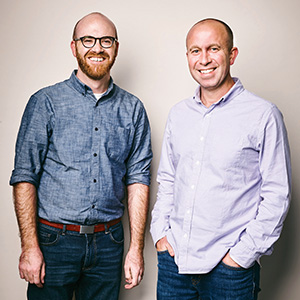Better Design through Data
Dean Malmgren and Mike Stringer (both PhD '09) join IDEO to explore creative ways to realize the positive potential of data science.
 Dean Malmgren and Mike Stringer are data guys—at least, that’s how they were perceived. It’s not hard to see why—they completed their PhDs in the lab of Professor Luís Amaral, where they conducted data science research, and then, in 2009, started a company called Datascope Analytics, where they hired data scientists to solve data problems for clients.
Dean Malmgren and Mike Stringer are data guys—at least, that’s how they were perceived. It’s not hard to see why—they completed their PhDs in the lab of Professor Luís Amaral, where they conducted data science research, and then, in 2009, started a company called Datascope Analytics, where they hired data scientists to solve data problems for clients.
There was only one issue.
“There’s no such thing as a data problem,” Stringer says. “Looking only at the data from the outset throws away a huge part of how you solve a problem. The data is actually just one resource for design thinking.”
Turns out they were designers all along, but now it’s official. After eight years of success, Datascope was acquired by design firm IDEO in October 2017. Though the two companies had partnered on projects for years, the acquisition brings together design and data to tackle the next frontier: augmented intelligence.
Getting their "MBA on the Streets"
Malmgren and Stringer hadn’t predicted this path when they were finishing their PhDs. The two knew they had a specific set of skills that
"Working in the Amaral lab, the idea of communicating science was not secondary,” Stringer says. “We practiced it all the time. We always kept the audience in mind while doing our research.”
As they finished their degrees, the two would walk around campus and talk about starting a data science business—how they would structure it, how they would get started.
From there, they opened their first official office in Chicago, where they earned their “MBA on the streets,” as Malmgren puts it. As founders of a bootstrapped startup, Malmgren and Stringer were all in, but when they hired their first employee, the pressure was on.
“There’s no such thing as a data problem. Looking only at the data from the outset throws away a huge part of how you solve a problem. The data is actually just one resource for design thinking.”
"We were either going to make this happen, have reasonable salaries and work/life balance, or we weren’t,” Malmgren says. “Hiring employees added a lot more incentive to make sure we didn’t screw it up.
As they worked on projects across the board—helping Procter & Gamble find and connect subject-matter experts within the company, helping Oracle predict solutions for hardware failure—they became better at articulating what exactly they did. “Our clients usually came to us with a too-narrow problem definition or a too-narrow idea of how they wanted to solve it,” Malmgren says. “That was usually an indication that there was room to learn about what the real nature of the problem was. We practiced human-centered data science, and we approached problems with a design process.”
What would IDEO do?
With this design-thinking mindset, Malmgren and Stringer regularly turned to IDEO for inspiration. They had become friends with IDEO Chicago partners Iain Roberts and Andrew Burroughs, who served as early mentors and collaborators with Datascope on projects. When faced with a client problem that seemed insurmountable, the first question Malmgren and Stringer would ask themselves was, “What would IDEO do?”
As their company grew, the
“We had a moment where we realized we had to mature as a business,” Malmgren says. “We were stressed out. We had everyone trying to do everything.” It became clear that they were
Coincidentally, they began talking with IDEO about working together, and they realized the value that lay in interdisciplinary teams. They thought back to their time in the Amaral lab, which they said was “truly interdisciplinary,” and relished the idea of working across boundaries to design solutions to problems. “Luís always had 20 different projects going across many fields,” Stringer recalls.
Both firms realized that to create those teams, they needed to do it as one entity. IDEO acquired Datascope and launched its new effort: Design for Augmented Intelligence (D4AI).
Giving People Superpowers
The initiative comes at an interesting time in technological innovation. Machine-learning algorithms have advanced far enough to be considered “intelligent,” but much of what is said about these technologies is negative—how algorithms can make mistakes, or be prejudicial, or make opaque decisions that cannot be understood. Malmgren and Stringer, however, see this technology as an opportunity to create positive impact not by creating artificial intelligence, but rather by augmenting human intelligence.
“We want to create intelligent systems that work for people rather than against them,” Stringer says. A representative project is a personal service to help people manage their health. Such a program could use data and machine-learning algorithms to understand what interventions might work best to keep a person healthy.
“We don’t want to change what they’re doing,” Malmgren says. “We want to give them superpowers.”
Malmgren and Stringer and their Datascope team are already working on a number of projects like this at IDEO (projects they can’t yet talk about). “We’re working on exciting projects that we didn’t have a chance to contribute to before,” Malmgren says.
"Going from the Amaral lab to Datascope to IDEO—we have used the same problem-solving approach. Our focus and scope
